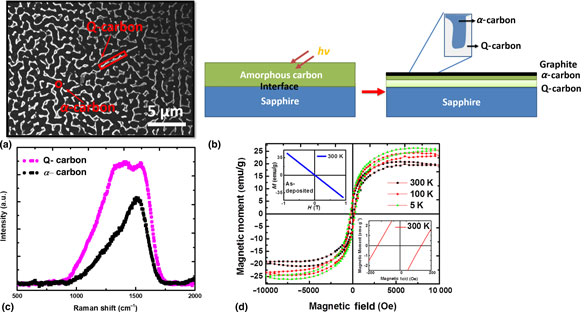Crossref Citations
This article has been cited by the following publications. This list is generated based on data provided by
Crossref.
Gupta, Siddharth
Sachan, Ritesh
Bhaumik, Anagh
and
Narayan, Jagdish
2018.
Enhanced mechanical properties of Q-carbon nanocomposites by nanosecond pulsed laser annealing.
Nanotechnology,
Vol. 29,
Issue. 45,
p.
45LT02.
Gupta, Siddharth
and
Narayan, Jagdish
2019.
Non-equilibrium processing of ferromagnetic heavily reduced graphene oxide.
Carbon,
Vol. 153,
Issue. ,
p.
663.
Zkria, Abdelrahman
Haque, Ariful
Egiza, Mohamed
Abubakr, Eslam
Murasawa, Koki
Yoshitake, Tsuyoshi
and
Narayan, Jagdish
2019.
Laser-induced structure transition of diamond-like carbon coated on cemented carbide and formation of reduced graphene oxide.
MRS Communications,
Vol. 9,
Issue. 3,
p.
910.
Gupta, Siddharth
Sachan, Ritesh
and
Narayan, Jagdish
2019.
Scale-up of Q‑carbon and nanodiamonds by pulsed laser annealing.
Diamond and Related Materials,
Vol. 99,
Issue. ,
p.
107531.
Narayan, J.
Gupta, S.
Sachan, R.J.
Niebroski, A.
and
Pant, P.
2019.
Formation of Q-carbon and diamond coatings on WC and steel substrates.
Diamond and Related Materials,
Vol. 98,
Issue. ,
p.
107515.
Gupta, Siddharth
Moatti, Adele
Bhaumik, Anagh
Sachan, Ritesh
and
Narayan, Jagdish
2019.
Room-temperature ferromagnetism in epitaxial titanium nitride thin films.
Acta Materialia,
Vol. 166,
Issue. ,
p.
221.
Sachan, Ritesh
Bhaumik, Anagh
Pant, Punam
Prater, John
and
Narayan, Jagdish
2019.
Diamond film growth by HFCVD on Q-carbon seeded substrate.
Carbon,
Vol. 141,
Issue. ,
p.
182.
Fominski, V. Yu.
Romanov, R. I.
Solov’ev, A. A.
Vasil’evskii, I. S.
Safonov, D. A.
Ivanov, A. A.
Zinin, P. V.
and
Filonenko, V. P.
2019.
Features of Pulsed Laser Annealing of BC3 Films on a Sapphire Substrate.
Technical Physics Letters,
Vol. 45,
Issue. 5,
p.
446.
Gupta, Siddharth
and
Narayan, Jagdish
2019.
Reduced Graphene Oxide/Amorphous Carbon P–N Junctions: Nanosecond Laser Patterning.
ACS Applied Materials & Interfaces,
Vol. 11,
Issue. 27,
p.
24318.
Yoshinaka, Hiroki
Inubushi, Seiko
Wakita, Takanori
Yokoya, Takayoshi
and
Muraoka, Yuji
2020.
Formation of Q-carbon by adjusting sp3 content in diamond-like carbon films and laser energy density of pulsed laser annealing.
Carbon,
Vol. 167,
Issue. ,
p.
504.
Burlakov, Victor M.
and
Goriely, Alain
2020.
Reverse Coarsening and the Control of Particle Size Distribution through Surfactant.
Applied Sciences,
Vol. 10,
Issue. 15,
p.
5359.
Sachan, Ritesh
Gupta, Siddharth
and
Narayan, Jagdish
2020.
Nonequilibrium Structural Evolution of Q-Carbon and Interfaces.
ACS Applied Materials & Interfaces,
Vol. 12,
Issue. 1,
p.
1330.
Gupta, Siddharth
and
Narayan, Jagdish
2020.
Direct conversion of Teflon into nanodiamond films.
Materials Research Letters,
Vol. 8,
Issue. 11,
p.
408.
Joshi, Pratik
Gupta, Siddharth
Haque, Ariful
and
Narayan, Jagdish
2020.
Fabrication of ultrahard Q-carbon nanocoatings on AISI 304 and 316 stainless steels and subsequent formation of high-quality diamond films.
Diamond and Related Materials,
Vol. 104,
Issue. ,
p.
107742.
Gupta, Siddharth
and
Narayan, Jagdish
2020.
Selective Liquid-Phase Regrowth of Reduced Graphene Oxide, Nanodiamond, and Nanoscale Q-Carbon by Pulsed Laser Annealing for Radiofrequency Devices.
ACS Applied Nano Materials,
Vol. 3,
Issue. 6,
p.
5178.
Zare, Yasser
and
Rhee, Kyong Yop
2020.
Modeling the Effects of Filler Network and Interfacial Shear Strength on the Mechanical Properties of Carbon Nanotube-Reinforced Nanocomposites.
JOM,
Vol. 72,
Issue. 6,
p.
2184.
Bai, Haiqiang
Zhong, Lisheng
Shang, Zhao
Cui, Pengjie
Kang, Ling
Lv, ZhenLin
and
Xu, Yunhua
2020.
Microstructure and Fracture Toughness of Compact TiC-Fe Gradient Coating Fabricated on Cast Iron Substrate by Two-Step In Situ Reaction.
JOM,
Vol. 72,
Issue. 6,
p.
2154.
Gupta, Siddharth
Joshi, Pratik
and
Narayan, Jagdish
2020.
Electron mobility modulation in graphene oxide by controlling carbon melt lifetime.
Carbon,
Vol. 170,
Issue. ,
p.
327.
Joshi, Pratik
Haque, Ariful
Gupta, Siddharth
Narayan, Roger J.
and
Narayan, Jagdish
2021.
Synthesis of multifunctional microdiamonds on stainless steel substrates by chemical vapor deposition.
Carbon,
Vol. 171,
Issue. ,
p.
739.
Narayan, J.
Bhaumik, A.
Gupta, S.
Joshi, P.
Riley, P.
and
Narayan, R.J.
2021.
Role of Q-carbon in nucleation and formation of continuous diamond film.
Carbon,
Vol. 176,
Issue. ,
p.
558.




